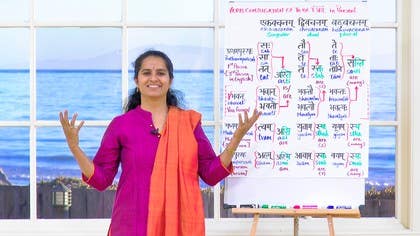Description
About This Video
Transcript
Read Full Transcript
Namaste. Welcome on the show again. Swagatam Allana. Welcome. What we will next look at is the pronoun you informal and see how it connects with the verb to be. We have looked at the verb to be in the third person singular which is asti is not nasty. And then we have also looked at you formal Bhavan or Bhavati. The verb is the same asti. So for example Bhavati Allana asti. Now what we will look at is the informal you which is a tvam and see how it affects the conjugation of the verb to be. So going back to the first third person singular Esha Allana asti. This is Allana. Esha Allana asti. Second person formal Bhavati Allana asti. Bhavati Allana asti. The verb remains the same. In the you informal however it takes on a slight change. tvam Allana asi. tvam Allana asi. All right. So what we are going to do together today is to look at the verb to be done with or conjugated with the second person informal which is tvam and also do the first person singular which is aham. So if I said tvam Allana asi when I speak of myself I would say aham anu asmi. Now if I had to have a conversation with Allana we get back to that picture where everybody in the world is speaking Sanskrit and we are meeting each other for the first time. You know that's not so true but we will play the game for you. So aham anu asmi bhavati kah asti who are you aham Allana asmi. If you noticed I asked the question in the formal manner I said bhavati kah asti who are you or rather who you are in, just pause bhavati kah asti. If you have to go literally with the order of the words it is you formal kah who are asti bhavati kah asti. Now if I had to use the you informal it would be tvam kah asi who are you but asi. Alright tvam kah asi aham Allana asmi. Would you like to ask me the question tvam tvam kah asti. Fantastic aham anu asmi and now if I can ask you who are you tvam kah asti or if you are a man tvam kah asti. You would answer aham your name asmi asmi. Alright we will just add a little more vocabulary to the possibilities of who I am. Let's see if we can introduce the different identities that we have. So tvam kah kah asti. If you notice I have said kah kah twice. In many Indian languages we repeat certain words and it just goes to say who who are you. What are the different identities you have? tvam kah kah asi. Allana aham aham Allana asmi. Okay something else. Now it might be a little complicated when you think of oh I don't know the Sanskrit word for something. Don't worry I would say mix and match. So if you have the English word for it just use it. So what else are you? aham a yoga teacher asmi uttamam. So yoga teacher is yoga shik shi ka. Shik shi ka for teacher. You want to say that? shik shi ka fantastic. So aham aham yoga shik shi ka ami asmi fantastic. Another if you want to talk of your gender aham nari nari asmi. Nari is a woman. So aham nari asmi. Right maybe you ask me now. tvam kah kah asi fantastic. So aham anu asmi aham bharatiya that's an Indian aham bharatiya asmi aham nari asmi aham samskrita priya asmi. I am a lover of Sanskrit aham samskrita priya asmi. I am a Sanskrit teacher as well. So aham samskrita shik shi ka asmi and most important the most fundamental or rather the most essential identity of our nature aham brahmasmi. I am that supreme truth. This is a very big sentence of the Upanishads declaring the essential identity of the individual aham brahmasmi. Alright if you want to have a go at it tvam kah kah kah if you are a man or kah kah asi who are you? Want to try that? aham asmi great another one aham asmi lovely. I think that this would help us a little more in clarifying our identity who we are and when we say it in Sanskrit maybe some things might change somewhere who knows. Enjoy, play with it. Namaste.
Mother Tongue: Verbs
Comments
You need to be a subscriber to post a comment.
Please Log In or Create an Account to start your free trial.










